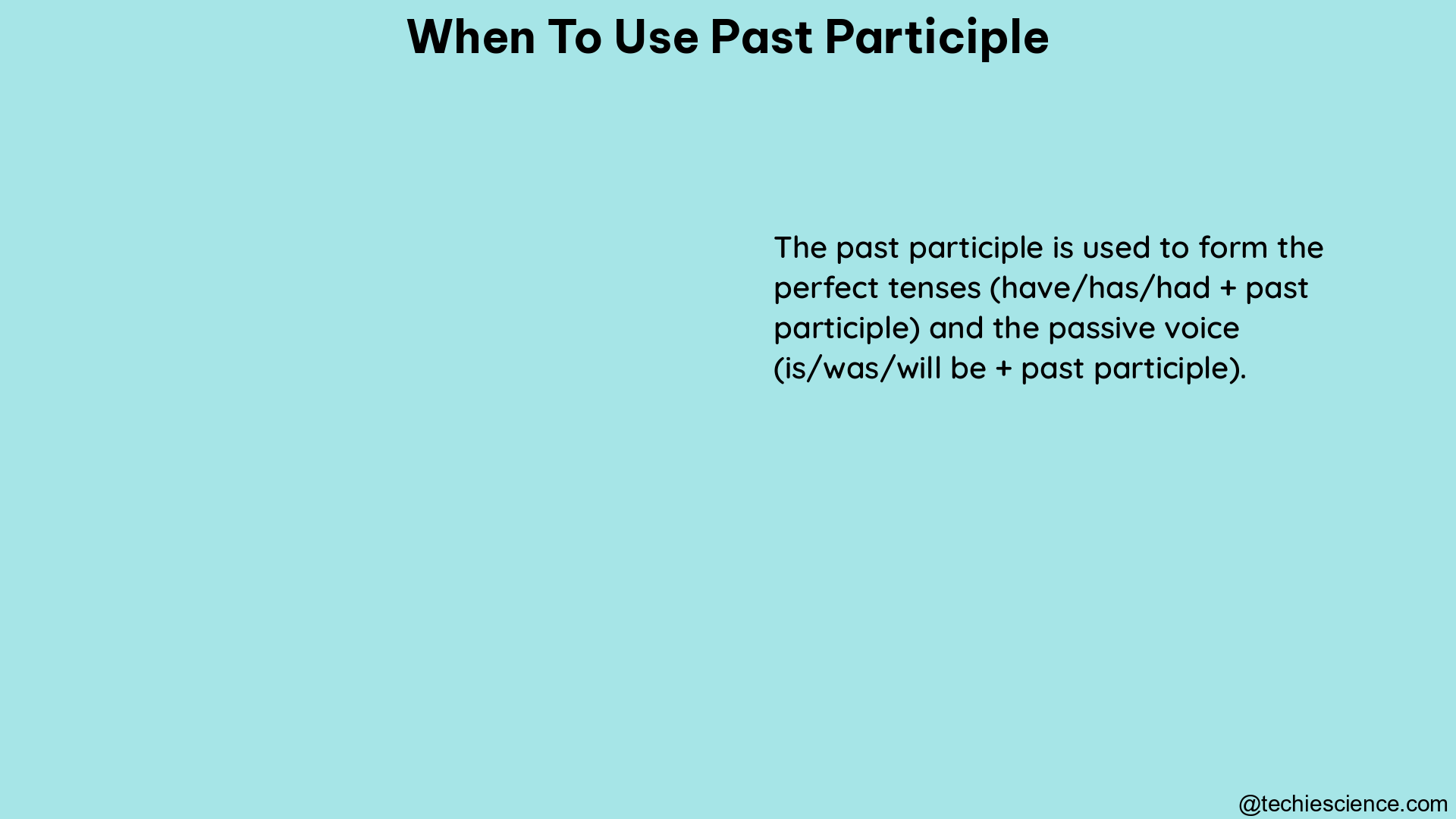Past participles are a fundamental aspect of English grammar, and understanding when to use them is crucial for effective communication. This comprehensive guide will delve into the various situations where past participles are employed, providing you with a thorough understanding of this essential grammatical concept.
1. Forming Perfect Tenses
One of the primary uses of past participles is in the formation of perfect tenses. These tenses combine an auxiliary verb (such as “have,” “has,” or “had”) with the past participle of the main verb to express completed actions or states.
Present Perfect
The present perfect tense is formed using the auxiliary verb “have” or “has” followed by the past participle of the main verb. This tense is used to describe actions or events that have been completed in the recent past or have an ongoing impact in the present.
Example:
– “I have eaten my lunch.” (The action of eating the lunch is completed in the recent past.)
Past Perfect
The past perfect tense is formed using the auxiliary verb “had” followed by the past participle of the main verb. This tense is used to describe an action or event that was completed before another past action or event.
Example:
– “By the time I arrived, she had finished her homework.” (The action of finishing the homework was completed before the arrival.)
Future Perfect
The future perfect tense is formed using the auxiliary verb “will have” followed by the past participle of the main verb. This tense is used to describe an action or event that will be completed before a specific future time.
Example:
– “By the end of the week, I will have completed all my assignments.” (The action of completing the assignments will be finished before the end of the week.)
2. Using Past Participles as Adjectives

Past participles can also function as adjectives, modifying nouns or pronouns. This usage can occur in two main ways:
Before the Noun
When a past participle is placed before a noun, it acts as an adjective, describing the noun.
Example:
– “The broken watch was repaired.” (The past participle “broken” modifies the noun “watch.”)
After a Linking Verb
Past participles can also be used as adjectives after a linking verb, such as “be,” “become,” or “seem.”
Example:
– “The students were bored during the lecture.” (The past participle “bored” modifies the noun “students.”)
3. Participle Phrases
Past participles are often used in participle phrases, which are adjectival phrases that modify a noun or pronoun. These phrases typically begin with a past participle and may include additional modifiers or prepositional phrases.
Example:
– “The baseball, signed by his childhood hero, was his most cherished possession.” (The past participle “signed” and the prepositional phrase “by his childhood hero” form the participle phrase that modifies the noun “baseball.”)
4. Passive Voice
Past participles are an essential component of the passive voice construction in English. In the passive voice, the subject of the sentence receives the action of the verb, rather than performing the action.
Example:
– “The cake was eaten by the children.” (The past participle “eaten” is used with the auxiliary verb “was” to form the passive voice.)
5. Expressing Regret or Completion
Past participles can be used with the modal verbs “should” or “shouldn’t” to express regret or a sense of completion.
Example:
– “They shouldn’t have run the first lap so fast.” (The past participle “run” is used with “shouldn’t have” to express regret over the action.)
Additional Examples
Here are some more examples to further illustrate the use of past participles:
- “I have written a letter to my friend.” (present perfect)
- “She had studied for the exam before the class.” (past perfect)
- “The door was locked by the security guard.” (passive voice)
- “The damaged car was towed away.” (past participle as adjective)
Key Takeaways
- Past participles are used with auxiliary verbs to form perfect tenses (present perfect, past perfect, and future perfect).
- Past participles can function as adjectives, modifying nouns or pronouns, either before the noun or after a linking verb.
- Participle phrases, beginning with a past participle, are used to modify nouns or pronouns.
- Past participles are essential in the construction of passive voice sentences.
- Past participles can be used with “should” or “shouldn’t” to express regret or a sense of completion.
By understanding these various applications of past participles, you can effectively incorporate them into your written and spoken English, enhancing your overall language proficiency.
References
- https://www.thoughtco.com/past-participle-1691592
- https://www.thesaurus.com/e/grammar/past-participles/
- https://mangolanguages.com/resources/learn/grammar/spanish/how-to-use-past-participles-in-spanish
- https://www.reddit.com/r/grammar/comments/18inkky/when_to_use_participle_or_past_tense/
- https://proofed.com/writing-tips/grammar-tips-what-is-a-past-participle/

Hi! I am Bhabesh Sing. I have completed M.A in English, M.A in Vocal Music, and B.Ed. I am a creative writer. Currently, I am a Subject Matter Expert in English on this Platform.
Let’s connect through LinkedIn-https://www.linkedin.com/in/bhabesh-sing-660914ab